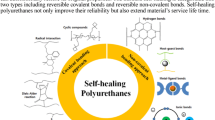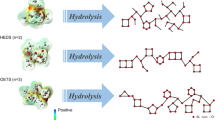Abstract
Most silicone polymers are linear compounds derived from dimethylsiloxane (D) monomers; the incorporation of tri- (T) and tetra-functional (Q) monomers usually leads to elastomers. MQ or MT resins, high value materials used as reinforcing agents, are exceptions in that they are very highly branched, and highly reticulated but remain mobile and fluid. We report the formation of analogous linear T- and Q-rich polymers. The Piers-Rubinsztajn (PR) reaction between Si(OEt)4 and HSiMe(OSiMe3)2 led to mixtures of highly branched monomers that were separated by distillation to provide mono- and dialkoxy-Q monomers. Chain extension, also using the PR reaction with telechelic HSi-modified silanes, led to small to medium size linear polymers that were rich in T and Q groups. The polymers were mobile fluids, typically with only slightly higher viscosities than their unbranched counterparts. Alternating silphenylene Q(TM2)2 copolymers were also fluids as a consequence of steric inhibition of aromatic group association. The PR reaction provides a simple and viable strategy to introduce spatially controlled branching in pure, linear silicone polymers.
Similar content being viewed by others
Data Availability
Data for this paper may be found in the main text and Supplementary Information.
References
Morgan J, Chen T, Hayes R, Dickie T, Urlich T, Brook MA (2017) Facile synthesis of dendron-branched silicone polymers. Polym Chem 8(18):2743–2746. https://doi.org/10.1039/C7PY00260B
Madsen FB, Dimitrov I, Daugaard AE, Hvilsted S, Skov AL (2013) Novel cross-linkers for PDMS networks for controlled and well distributed grafting of functionalities by click chemistry. Polym Chem 4(5):1700–1707. https://doi.org/10.1039/C2PY20966G
Brook MA (2000) Silicones. Silicon in organic, organometallic and polymer chemistry. Wiley, New York, pp 256–308
Tatarinova E, Vasilenko N, Muzafarov A (2017) Synthesis and properties of MQ copolymers: current state of knowledge. Molecules 22(10). https://doi.org/10.3390/molecules22101768
Flagg DH, McCarthy TJ (2016) Rediscovering silicones: MQ copolymers. Macromolecules 49(22):8581–8592. https://doi.org/10.1021/acs.macromol.6b01852
Huang Z, Wu J, Liu X, Ji H, He R, Liu R, Pimhataivoot P, Chen X (2018) Versatile Cascade Esterification Route to MQ Resins. ACS Omega 3(4):4054–4062. https://doi.org/10.1021/acsomega.8b00121
Zheng S, Liang S, Chen Y, Brook MA (2019) Hyperbranched silicone MDTQ tack promoters. Molecules 24(22):4133. https://doi.org/10.3390/molecules24224133
Schmidt RG, Gordon GV, Dreiss CA, Cosgrove T, Krukonis VJ, Williams K, Wetmore PM (2010) A critical size ratio for viscosity reduction in poly(dimethylsiloxane)−Polysilicate nanocomposites. Macromolecules 43(23):10143–10151. https://doi.org/10.1021/ma1004919
Charlesby A (1955) Viscosity measurements in branched silicones. J Polym Sci 17:379–390. https://doi.org/10.1002/pol.1955.120178506
Villar MA, Vallés EM (1996) Influence of pendant chains on mechanical properties of model poly(dimethylsiloxane) networks. 2. Viscoelastic properties. Macromolecules 29(11):4081–4089. https://doi.org/10.1021/ma9506602
Bibbo MA, Valles EM (1984) Influence of pendant chains on the loss modulus of model networks. Macromolecules 17(3):360–365. https://doi.org/10.1021/ma00133a018
Muzafarov AM, Rebrov EA (2008) From the discovery of sodiumoxyorganoalkoxysilanes to the organosilicon dendrimers and back. J Polym Sci A Polym Chem 46(15):4935–4948. https://doi.org/10.1002/pola.22795
Boldyrev K, Tatarinova E, Meshkov I, Vasilenko N, Buzin M, Novikov R, Vasil'ev V, Shtykova E, Feigin L, Bystrova A, Chvalun S, Muzafarov A (2019) New approach to the synthesis of polymethylsilsesquioxane dendrimers. Polymer 174:159–169. https://doi.org/10.1016/j.polymer.2019.04.030
Brook MA, Grande JB, Ganachaud F (2011) New synthetic strategies for structured silicones using B(C6F5)3. In: Muzafarov AM (ed) Silicon polymers. Springer, Berlin, pp 161–183. https://doi.org/10.1007/12_2009_47
Brook MA (2018) New control over silicone synthesis using SiH chemistry: the Piers–Rubinsztajn reaction. Chem Eur J 24(34):8458–8469. https://doi.org/10.1002/chem.201800123
Piers WE (2004) The chemistry of Perfluoroaryl boranes. Advances in organometallic chemistry, vol 52. Academic Press, Cambridge, pp 1–76. https://doi.org/10.1016/S0065-3055(04)52001-4
Rubinsztajn S, Cella JA (2005) A new Polycondensation process for the preparation of Polysiloxane copolymers. Macromolecules 38(4):1061–1063. https://doi.org/10.1021/ma047984n
Thompson DB, Brook MA (2008) Rapid assembly of complex 3D siloxane architectures. J Am Chem Soc 130(1):32–33. https://doi.org/10.1021/ja0778491
Liao M, Chen Y, Brook MA (2021) Spatially controlled highly branched Vinylsilicones. Polymers 13(6). https://doi.org/10.3390/polym13060859
Melendez-Zamudio M, Chavda K, Brook MA (2022) Chelating silicone Dendrons: trying to impact organisms by disrupting ions at interfaces. Molecules 27(6). https://doi.org/10.3390/molecules27061869
Mourey TH, Turner SR, Rubinstein M, Frechet JMJ, Hawker CJ, Wooley KL (1992) Unique behavior of dendritic macromolecules: intrinsic viscosity of polyether dendrimers. Macromolecules 25(9):2401–2406. https://doi.org/10.1021/ma00035a017
Kocienski P (2005) Protecting groups3rd edn. Thieme, Stuttgart
Wuts PGM, Greene TW (2006) Greene's protective groups in organic synthesis4th edn. Wiley-Interscience, New Jersey
Silicone Fluids: Stable, Inert Media, in Silicon Compounds: Silanes & Silicones, Gelest, Inc., 11 East Steel Road, Morrisville, PA 19067 USA; downloaded from http://www.gelest.com/literature.asp Dec. 2014
Liang S, Wong MY, Schneider A, Liao M, Kräuter G, Tchoul M, Chen Y, Brook MA (2020) Transparent Silphenylene elastomers from highly branched monomers. Polym Chem. https://doi.org/10.1039/D0PY01148G
Dvornic PR, Lenz RW (1994) Exactly alternating silarylene-siloxane polymers. 10. Synthesis and characterization of silphenylene-siloxane polymers containing fluoroalkyl and hydrido side groups. Macromolecules 27(20):5833–5838. https://doi.org/10.1021/ma00098a042
Schneider AF, Laidley E, Brook MA (2019) Facile synthesis of cx(AB)yCx triblock silicone copolymers utilizing moisture mediated living-end chain extension. Macromol Chem Phys 220(8):1800575. https://doi.org/10.1002/macp.201800575
Tatarinova E, Vasilenko N, Muzafarov A (2017) Synthesis and properties of MQ copolymers: current state of knowledge. Molecules 22(10):1768–1768. https://doi.org/10.3390/molecules22101768
Mrozek RA, Cole PJ, Otim KJ, Shull KR, Lenhart JL (2011) Influence of solvent size on the mechanical properties and rheology of polydimethylsiloxane-based polymeric gels. Polymer 52(15):3422–3430. https://doi.org/10.1016/j.polymer.2011.05.021
Okui N, Li HM, Magill JH (1978) Thermal properties of poly(tetramethyl-p-silphenylene siloxane) and (tetramethyl-p-silphenylene siloxane-dimethyl siloxane) copolymers. Polymer 19(4):411–415. https://doi.org/10.1016/0032-3861(78)90247-1
Magill JH (1964) Crystallization of poly-(Tetramethyl-p-Silphenylene)-siloxane polymers. J Appl Phys 35(11):3249–3259. https://doi.org/10.1063/1.1713206
Magill JH (1967) Crystallization of poly(tetramethyl-p-silphenylene)-siloxane (TMPS) polymers. Part II. J Polym Sci Part A-2: Polym Physics 5(1):89–99. https://doi.org/10.1002/pol.1967.160050108
Merker RL, Scott MJ, Haberland GG (1964) Random and block copolymers of poly(tetramethyl-p-silphenylene-siloxane) and polydimethylsiloxane. J Polym Sci Part A: Gen Papers 2(1):31–44. https://doi.org/10.1002/pol.1964.100020103
Dvornic PR, Perpall HJ, Uden PC, Lenz RW (1989) Exactly alternating silarylene–siloxane polymers. VII. Thermal stability and degradation behavior of p-silphenylene–siloxane polymers with methyl, vinyl, hydrido, and/or fluoroalkyl side groups. J Polym Sci A Polym Chem 27(10):3503–3514. https://doi.org/10.1002/pola.1989.080271027
Liang S, Wong MY, Schneider A, Liao M, Kräuter G, Tchoul MN, Chen Y, Brook MA (2021) Transparent silphenylene elastomers from highly branched monomers. Polym Chem 12(2):209–215. https://doi.org/10.1039/D0PY01148G
Hanwell MD, Curtis DE, Lonie DC, Vandermeersch T, Zurek E, Hutchison GR (2012) Avogadro: an advanced semantic chemical editor, visualization, and analysis platform. J Cheminform 4(1):17. https://doi.org/10.1186/1758-2946-4-17
Schneider AF, Brook MA (2019) High-throughput synthesis and characterization of aryl silicones by using the Piers–Rubinsztajn reaction. Chem Eur J 25(67):15367–15374. https://doi.org/10.1002/chem.201903658
Acknowledgments
We acknowledge with gratitude the financial support of the Natural Sciences and Engineering Council of Canada and the Faculty of Science, McMaster University for an equipment grant.
Funding
This research was supported by the Natural Sciences and Engineering Council of Canada.
Author information
Authors and Affiliations
Contributions
The original concept of this research was proposed by Dr. Brook. All synthetic research on QT compounds was performed by Dr. Wong. These two coauthors shared the writing activities. Dr. Chen and Dr. Bui provided additional physical characterization, and Dr. Schneider and Mr. Vishnu prepared the D silphenylene polymers for comparison purposes. All authors consent to publication of the work in its current form.
Corresponding author
Ethics declarations
Ethics Approval
Not applicable.
Consent to Participate
Not applicable.
Consent for Publication
All authors consent to publication of the manuscript in its current form.
Competing Interests
The authors declare they have no relevant financial or non-financial interests to disclose.
Additional information
Publisher’s Note
Springer Nature remains neutral with regard to jurisdictional claims in published maps and institutional affiliations.
Rights and permissions
Springer Nature or its licensor holds exclusive rights to this article under a publishing agreement with the author(s) or other rightsholder(s); author self-archiving of the accepted manuscript version of this article is solely governed by the terms of such publishing agreement and applicable law.
About this article
Cite this article
Wong, M.Y., Vishnu, I.L., Bui, R. et al. T- and Q-rich Linear Silicones from the Piers-Rubinsztajn Reaction. Silicon 15, 887–895 (2023). https://doi.org/10.1007/s12633-022-02064-0
Received:
Accepted:
Published:
Issue Date:
DOI: https://doi.org/10.1007/s12633-022-02064-0




